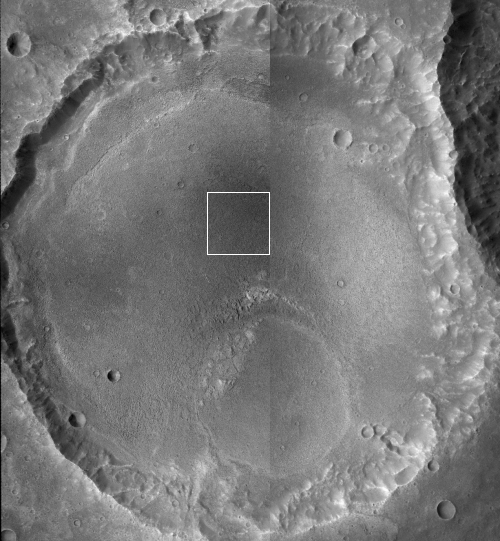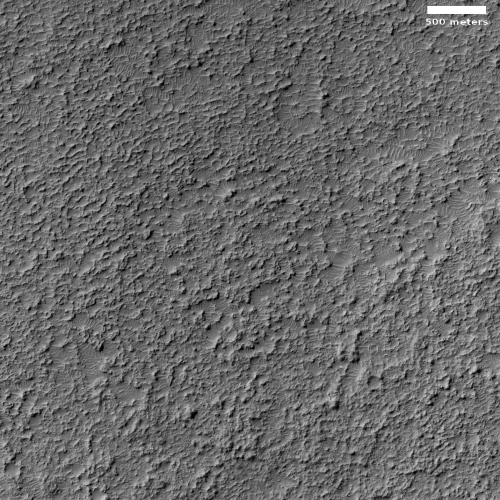Badlands on the floor of a Martian crater
Cool image time! The photo to the right, rotated, cropped, and reduced to post here, shows one small section of a 30-mile-wide unnamed crater in the cratered equatorial regions of Mars northeast of Hellas Basin. Taken on July 21, 2021 by the high resolution camera on Mars Reconnaissance Orbiter (MRO), the science team labeled merely as “Rocky crater fill.”
Being at 17 degrees south latitude, there shouldn’t be any ice features in this crater, and the high resolution image to the right seems to confirm this. All we see is an endless plain made up of innumerable small sharp rock ridges interspersed with small low areas filled with sand dunes. This is bed rock, and if its strange stucco-like appearance was caused by a past glacial era, that era is long gone.
Below is a mosaic showing the entire crater, created from two MRO context camera images.

Click here and here for original photos.
The original images were rotated, cropped, and reduced to post here. The white box marks approximately the area covered by the photo above, though the lack of distinct features makes it difficult to place that box precisely.
At first glance the multi-circular layers inside the crater suggest glacial fill in craters in the mid-latitudes that scientists have labeled concentric crater fill. A closer look however proves this wrong, because that glacial fill normally looks soft and slushy with many erosion features. The circular features here are once again bedrock and hard.
Most likely we are looking at some lava feature, possible impact melt from several superimposed impacts. The volcanic features could also be from flood lava. If you look at the full image of the two context camera pictures you can see other craters distorted as if they had been partly overrun by lava. There are also a lot of other circular features in this region that appear to be either very ancient eroded craters or craters mostly buried by lava.
Exploring of this crater floor is going to require some form of helicopter not unlike Ingenuity. Driving across its rough surface will likely be too difficult. Better to hop from point to point.
On Christmas Eve 1968 three Americans became the first humans to visit another world. What they did to celebrate was unexpected and profound, and will be remembered throughout all human history. Genesis: the Story of Apollo 8, Robert Zimmerman's classic history of humanity's first journey to another world, tells that story, and it is now available as both an ebook and an audiobook, both with a foreword by Valerie Anders and a new introduction by Robert Zimmerman.
The print edition can be purchased at Amazon or from any other book seller. If you want an autographed copy the price is $60 for the hardback and $45 for the paperback, plus $8 shipping for each. Go here for purchasing details. The ebook is available everywhere for $5.99 (before discount) at amazon, or direct from my ebook publisher, ebookit. If you buy it from ebookit you don't support the big tech companies and the author gets a bigger cut much sooner.
The audiobook is also available at all these vendors, and is also free with a 30-day trial membership to Audible.
"Not simply about one mission, [Genesis] is also the history of America's quest for the moon... Zimmerman has done a masterful job of tying disparate events together into a solid account of one of America's greatest human triumphs."--San Antonio Express-News
Cool image time! The photo to the right, rotated, cropped, and reduced to post here, shows one small section of a 30-mile-wide unnamed crater in the cratered equatorial regions of Mars northeast of Hellas Basin. Taken on July 21, 2021 by the high resolution camera on Mars Reconnaissance Orbiter (MRO), the science team labeled merely as “Rocky crater fill.”
Being at 17 degrees south latitude, there shouldn’t be any ice features in this crater, and the high resolution image to the right seems to confirm this. All we see is an endless plain made up of innumerable small sharp rock ridges interspersed with small low areas filled with sand dunes. This is bed rock, and if its strange stucco-like appearance was caused by a past glacial era, that era is long gone.
Below is a mosaic showing the entire crater, created from two MRO context camera images.

Click here and here for original photos.
The original images were rotated, cropped, and reduced to post here. The white box marks approximately the area covered by the photo above, though the lack of distinct features makes it difficult to place that box precisely.
At first glance the multi-circular layers inside the crater suggest glacial fill in craters in the mid-latitudes that scientists have labeled concentric crater fill. A closer look however proves this wrong, because that glacial fill normally looks soft and slushy with many erosion features. The circular features here are once again bedrock and hard.
Most likely we are looking at some lava feature, possible impact melt from several superimposed impacts. The volcanic features could also be from flood lava. If you look at the full image of the two context camera pictures you can see other craters distorted as if they had been partly overrun by lava. There are also a lot of other circular features in this region that appear to be either very ancient eroded craters or craters mostly buried by lava.
Exploring of this crater floor is going to require some form of helicopter not unlike Ingenuity. Driving across its rough surface will likely be too difficult. Better to hop from point to point.
On Christmas Eve 1968 three Americans became the first humans to visit another world. What they did to celebrate was unexpected and profound, and will be remembered throughout all human history. Genesis: the Story of Apollo 8, Robert Zimmerman's classic history of humanity's first journey to another world, tells that story, and it is now available as both an ebook and an audiobook, both with a foreword by Valerie Anders and a new introduction by Robert Zimmerman.
The print edition can be purchased at Amazon or from any other book seller. If you want an autographed copy the price is $60 for the hardback and $45 for the paperback, plus $8 shipping for each. Go here for purchasing details. The ebook is available everywhere for $5.99 (before discount) at amazon, or direct from my ebook publisher, ebookit. If you buy it from ebookit you don't support the big tech companies and the author gets a bigger cut much sooner.
The audiobook is also available at all these vendors, and is also free with a 30-day trial membership to Audible.
"Not simply about one mission, [Genesis] is also the history of America's quest for the moon... Zimmerman has done a masterful job of tying disparate events together into a solid account of one of America's greatest human triumphs."--San Antonio Express-News


